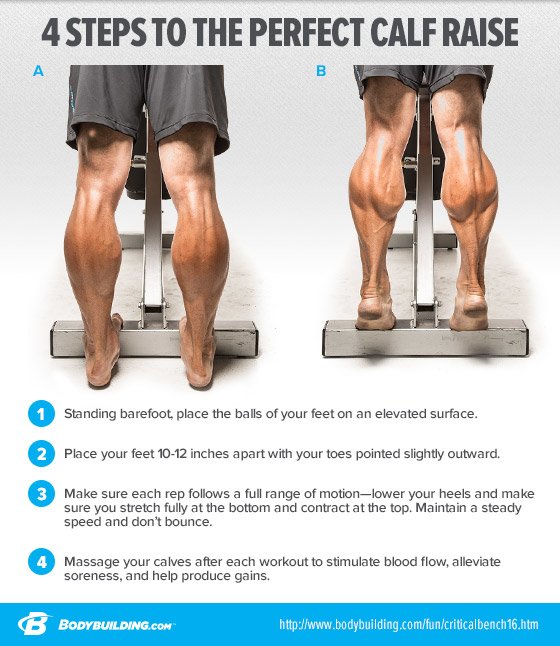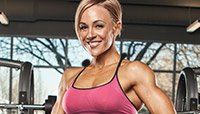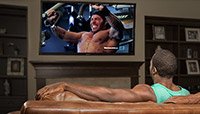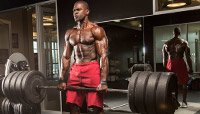
Calf Exercise Specialization
Try this calf specialization program if you need to add an inch or so to your lower legs.
For every body part, there are numerous programs and techniques for developing them, and calves are no exception. Try this calf specialization program if you need to add an inch or so to your lower legs. I've had some good results from this program and you might also.
You will need to give it four weeks in order to determine if you are going to get satisfactory results. In any event, your efforts will not go unrewarded. If after that length of time you feel you are making progress, then naturally, keep going.
Big Calves & Genetics
You're either blessed with good calf muscles, or you're not. I have seen some people who have never lifted a weight in their lives walk around with some of the largest and well-shaped calf muscles you could find on any Mr. Olympia. At the same time, I have seen seasoned professional bodybuilders who are weak in the calf department.

Genetics plays a major role here, and although you can improve on any situation, there are limits. Just don't be quick to blame poor calf development on your genetics. I have seen some who have done just that when in reality, their weak calf development was more a result from being lazy than genetics.
I have never been a big supporter of doing weighted 20-30 reps for calf development.
I have always been about keeping the reps in the 10-15 range, sometimes even less. This of course is with heavy weights. Now here's the catch: This program must be followed as outlined, and you cannot make any changes to the routine. You will work your calves four days per week—wo heavy days and two light days—and you must leave sufficient time between the days for recovery. This is why I say you cannot alter this program, either exercises or days prescribed.
Start each movement by standing on a block of wood or weight plate at least as high as a 2 x 4. Place your feet so that only your toes and the balls of your feet are on the block. Point your toes slightly outward. Your feet should be spaced about 10-12 inches from center of big toe to center of big toe. It is best if you do not wear any shoes. Barefoot is the preferred method.
If you do wear shoes, make certain they have very flexible soles. Stiff shoes have to go. You must stretch all the way down on each rep, and you must come all the way up on your toes. Concentrate on placing your weight on your big toe and the toe next to your big toe, and contract fully at the top. Do this on each rep of every set for every exercise outlined.

On Monday and Thursday you will use heavy weights and on Tuesdays and Fridays you will use body weight only. No weights at all. On Tuesdays and Fridays with body weight only, you will perform standing calf raises in the same position, on the same block, using the same technique as you apply on Mondays. Only on Tuesdays and Fridays, using body weight only, you are to perform 100 reps of standing calf raises.
Start by performing 4 sets of 25 reps with not more than 30 seconds rest between sets. Work up to doing 2 sets of 50 reps. Finally, try for a single set of 100 reps.
If you can do 2 sets of 50 reps, you can be proud. It is essential that you perform these reps properly. That means no "bouncing" up and down. Do not perform them extremely fast nor extremely slow. You must get a full stretch at the bottom and a full contraction at the top.
I also suggest you massage your calves well after each workout. This will not only help with the soreness that is sure to come, it will help invigorate the calf muscle with blood and help produce gains. If you do not have access to a massage therapist, use a hand-held massager. If you do not have one, you can use a rough towel and rub your calves briskly for several minutes after each session.
The Program
Monday
-
Standing calf raise: Use either a regular standing calf machine or a Smith machine. Perform five sets using the maximum weight you can use to perform the sets and reps correctly. 5 sets of 15, 12, 10, 8, 6.
-
Bodyweight-only standing calf raises. 100 reps.
-
Seated calf raise: Perform 5 sets using the maximum weight you can use in performing the movement correctly. If you do not have access to a seated calf machine, perform standing calf raises as performed on Mondays. 5 sets of 15, 12, 10, 8, 6.
-
Bodyweight-only standing calf raises. 100 reps.
Tuesday
Thursday
Friday
Conclusion
This is an extremely difficult exercise routine for the calves and will produce a great amount of soreness at the start regardless of how advanced you are in your training. You've been warned!
Recommended For You

Body By Jessie: Epic New Video Article!
Take a behind-the-scenes look at how Jessie Hilgenberg built her incredible physique! Learn from her journey and get motivated to build your own ideal body.
60 Seconds That Will Change Your Life
Bodybuilding.com is dedicated to changing lives through information, motivation, and supplementation. Watch our new commercials and spread the word!
